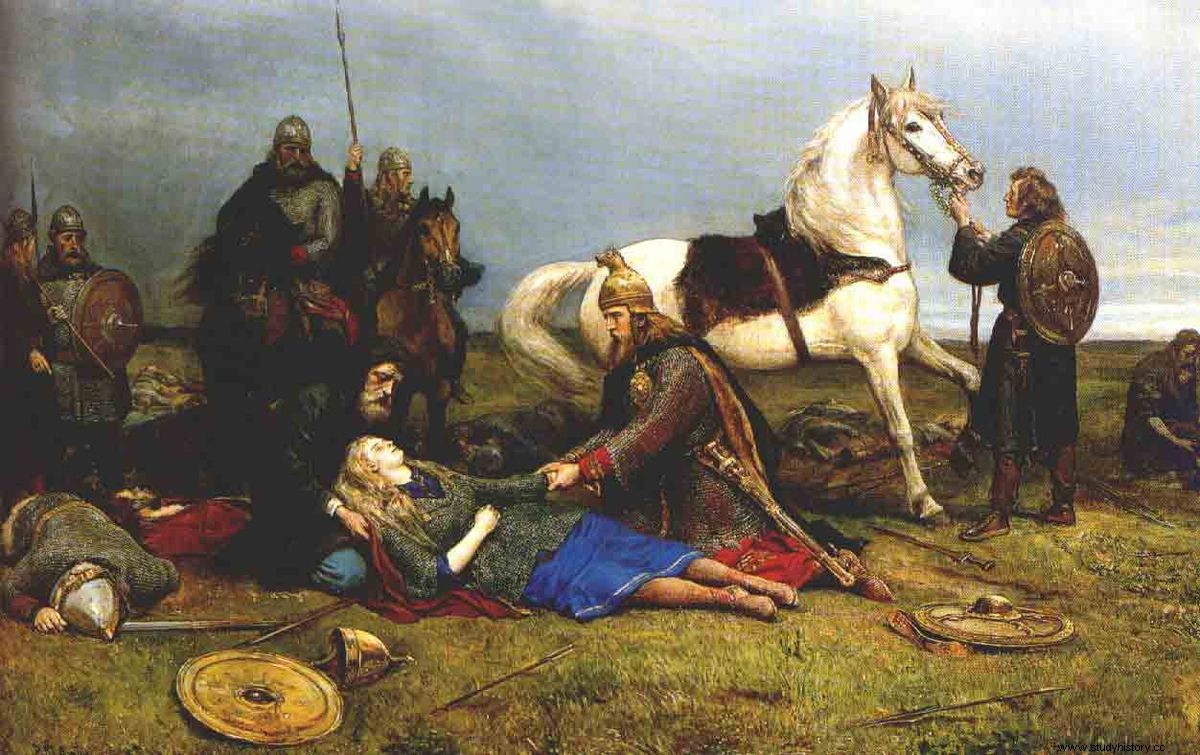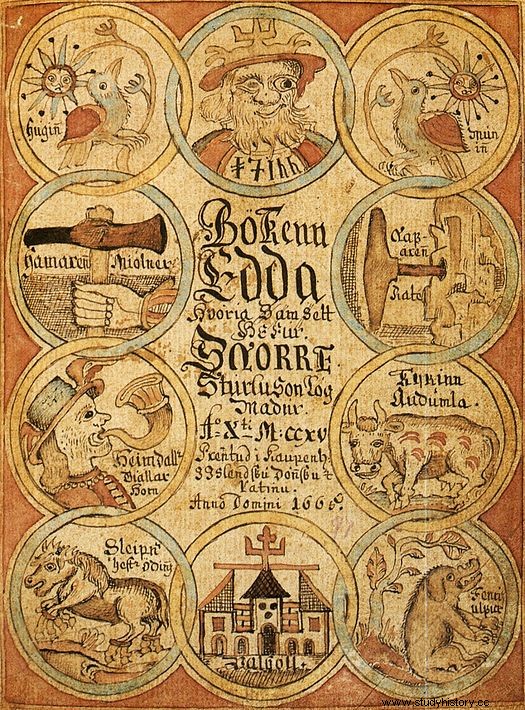In Sweden, the archaeological site of Birka includes the tomb of an important Viking warrior, buried with weapons, horses and symbols of warlike tactics and strategies. A man's grave, its discoverers surmised. Until studies revealed that it was actually a woman.

The skjaldmös , women and warriors
“Ladgerda, a gifted Amazon, who, despite being a young girl, had the courage of a man, and fought among the bravest with her loose hair flowing over her shoulders. All marveled at her incomparable deeds, as her hair flying down her back betrayed the fact that she was a woman. (The Danish Gesture – Gesta Danorum , Saxo Grammaticus)
“Out of the city of Sile, under Captains Hetha (Heid) and Wisna, with Hakon Cut Cheek came Tummi Veilmaker. On these captains, who had the bodies of women, nature had placed the souls of men. Webiorg was inspired by the same spirit and was served by Bo (Bui) and Brat the Jute, thirsty for war” (idem)
Brunhild, Hervor (English), Brynhild, Thornbjörg, Veborg (English), Lagertha, Freydis Eiriksdottir… From the Middle Ages, Nordic sagas, poems and historical chronicles depict skjaldmös , these female warriors armed with shields. They carry swords and armour, fight alongside men, lead attacks.
Despite the representation of the skjaldmös in the texts, these fighters remain largely considered as mythological elements without historical basis. In 2014, a discovery, confirmed in 2017, shattered certainties. In a Swedish site, in fact, researchers identify a female body… in a tomb intended for a great warrior.

Birka's website
Located on the island of Björkö, thirty kilometers west of Stockholm in Sweden, the site of Birka is that of an ancient city active between the 8th and 10th centuries. During part of the Viking Age, Birka was one of the most important towns; it owes its opulence to its position as the hub of a commercial, cultural and social network that extends as far as the Urals and the Byzantine Empire. A role that brings it into contact with many other cultures, which sometimes influence the practices and daily life of its inhabitants.
Populated by craftsmen, warriors and traders, Birka has between 700 and 1,000 inhabitants. Today, the archaeological site is characterized by its vast set of burials, one of the largest known in the Viking world. More than 3,000 tombs are known, distributed in vast cemeteries surrounding the city. About 1,100 of these graves have been excavated, revealing through the objects buried with the deceased the richness and diversity of cultural influences mixed with Birka.
Among these tombs, tomb Bj 581.

Tomb Bj 581
In the 1870s, archaeologist and ethnographer Hjalmar Stolpe excavated the tomb of a warrior buried at Birka, to which he assigned the name tomb Bj 581. Marked by a large stone boulder, the tomb is on a raised terrace , direct contact with the city garrison. A body is found seated there, dressed in clothes decorated with silk and silver threads. Among the possessions buried beside him are a warrior's full gear:a sword, an axe, a spear, arrows, a knife, two shields, a mare and a stallion. Game pieces, associated with few warrior graves, indicate an ability to think military strategy.
The tomb is in all respects that of the archetype of the Viking warrior, and his gender is not in doubt for those who discover the tomb:these martial attributes are necessarily masculine, it is therefore a question of a man, experienced in the battle. The conclusion is not, or almost, questioned until recently:in the 1970s, an osteologist points out that the bones have female characteristics, but the hypothesis is then not accepted. It took until 2014 for a study to really look into the matter.

A woman's body
In 2014, an osteological study conducted by the bioarchaeologist from Uppsala University in Sweden confirms the hypothesis:the bones are female, and the great warrior was in fact a great warrior. In the middle of archeology, voices immediately question the discovery:the bones could have been moved, mixed, confused with those of another tomb.
To answer these doubts, a team under the supervision of archaeologist Charlotte Hedenstierna-Jonson conducted a DNA study of the bones in 2017. The results of the study are clear:the DNA is female and indicates the presence of a single individual in the tomb. The Viking warrior had reached an age beyond 30, and the study points to a mobile lifestyle.
Despite these results, the discovery continues to raise questions for some, arguing that the bones discovered more than a century ago could have been mixed up or that the presence of weapons in the tomb does not indicate that it is of a warrior. What the authors of the study answer:
“Similar associations of women buried with weapons have been dismissed, arguing that the armaments could have been heirlooms, carriers of symbolic meaning or grave goods reflecting the status and role of the family rather than the individual (…). Male individuals in burials with a similar material record are not questioned in the same way. (…) The interpretation of grave goods is not straight forward, but it must be stressed that the interpretation should be made in a similar manner regardless of the biological sex of the interred individual. »
(Similar associations of women buried with guns have been dismissed, arguing that the guns may be heirlooms, symbols, or grave goods reflecting the status and role of the family rather than the individual (…). (… ) Interpretation of grave goods is not straightforward, but it should be emphasized that interpretation should be done the same regardless of the biological sex of the deceased.)
“Full members of male-dominated spheres”
The discovery of a particular case does not allow to extend conclusions or to draw generalities on the whole of the Viking Age. She suggests, however, as the study concludes, that women could then become “full members of male-dominated spheres” (“women, indeed, were able to be full members of male dominated spheres”) . And shakes the image of a strongly patriarchal society hitherto commonly accepted.
“Then the noble lady saw that their fight was hard,
With a resolute heart, she threw off her coat;
She grabbed her naked sword to protect her loved ones. »
Atlamál in grœnlenzku

